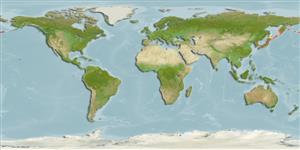>
Perciformes/Zoarcoidei (Eelpouts and pricklebacks) >
Zoarcidae (Eelpouts) > Lycodinae
Etymology: Lycenchelys: Greek, lykos = wolf + Greek, enchelys, -yos = eel (Ref. 45335); maculata: Named in reference to its dark spots (Ref. 43683).
Environment: milieu / climate zone / depth range / distribution range
Ökologie
seewasser bathydemersal; tiefenbereich 200 - 300 m (Ref. 43683). Deep-water
Northwest Pacific: Japan and the Russian Federation.
Size / Gewicht / Alter
Maturity: Lm ? range ? - ? cm
Max length : 29.8 cm TL Männchen/unbestimmt; (Ref. 43683)
Kurzbeschreibung
Bestimmungsschlüssel | Morphologie | Morphometrie
Rückenflossenstacheln (insgesamt) : 0; Rückenflossenweichstrahlen (insgesamt) : 131 - 138; Afterflossenstacheln: 0; Afterflossenweichstrahlen: 114 - 120; Wirbelzahl: 138 - 147. Body and dorsal fin with many clear dark blotches. Vertical fin rays and vertebrae numerous; abdominal vertebrae 27 or 28, and caudal ones 111-120 (Ref. 43683).
Life cycle and mating behavior
Geschlechtsreife | Fortpflanzung | Ablaichen | Eier | Fecundity | Larven
Anderson, M.E., 1994. Systematics and osteology of the Zoarcidae (Teleostei: Perciformes). Ichthyol. Bull. J.L.B. Smith Inst. Ichthyol. 60:120 p. (Ref. 11954)
IUCN Rote Liste Status (Ref. 130435: Version 2024-1)
Bedrohung für Menschen
Harmless
Nutzung durch Menschen
Tools
Zusatzinformationen
Download XML
Internet Quellen
Estimates based on models
Phylogenetic diversity index (Ref.
82804): PD
50 = 0.5000 [Uniqueness, from 0.5 = low to 2.0 = high].
Bayesian length-weight: a=0.00120 (0.00058 - 0.00248), b=3.10 (2.91 - 3.29), in cm total length, based on LWR estimates for this (Sub)family-body shape (Ref.
93245).
Trophic level (Ref.
69278): 3.4 ±0.5 se; based on size and trophs of closest relatives
Widerstandsfähigkeit (Ref.
120179): niedrig, Verdopplung der Population dauert 4,5 - 14 Jahre. (Preliminary K or Fecundity.).
Fishing Vulnerability (Ref.
59153): Low vulnerability (20 of 100).
